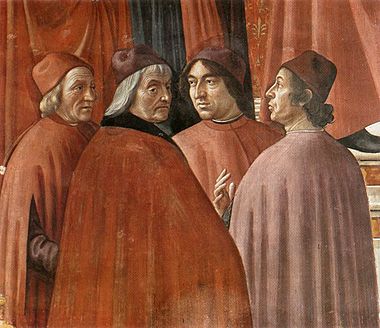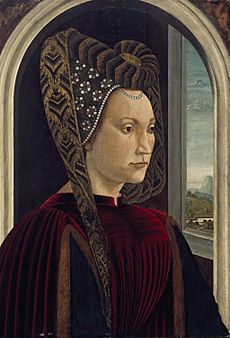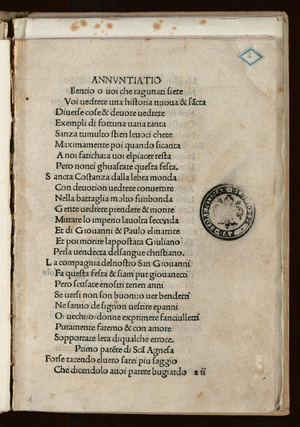Lorenzo de' Medici facts for kids
Quick facts for kids
Lorenzo de' Medici
|
|
|---|---|
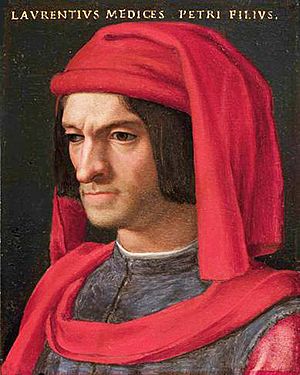
|
|
| Lord of Florence | |
| Reign | 2 December 1469 – 8 April 1492 |
| Predecessor | Piero the Gouty |
| Successor | Piero the Unfortunate |
| Full name |
Lorenzo di Piero de' Medici
|
| Born | 1 January 1449 Florence, Republic of Florence |
| Died | 8 April 1492 (aged 43) Careggi, Republic of Florence |
| Noble family | Medici |
| Spouse(s) | Clarice Orsini |
| Issue |
|
| Father | Piero the Gouty |
| Mother | Lucrezia Tornabuoni |
| Signature |  |
Lorenzo de' Medici (born January 1, 1449 – died April 8, 1492) was a very important Italian leader and banker. He was the unofficial ruler of the Florentine Republic and a huge supporter of Renaissance art and culture in Italy.
People called him Lorenzo the Magnificent (Lorenzo il Magnifico). He was a skilled diplomat, politician, and a generous supporter of scholars, artists, and poets. He is famous for helping artists like Botticelli and Michelangelo. Lorenzo helped keep peace among the different Italian states for many years. His life happened during the peak of the Italian Renaissance and a golden age for Florence. He is buried in the Medici Chapel in Florence.
Contents
Who Was Lorenzo the Magnificent?
Lorenzo de' Medici came from the powerful Medici family. They were very rich bankers and leaders in Florence. His grandfather, Cosimo de' Medici, was the first Medici to lead Florence and run the family bank at the same time. Cosimo spent a lot of his money on public projects and supporting artists.
Lorenzo's father, Piero di Cosimo de' Medici, also played a big role in Florence. He was known for collecting art and supporting artists. Lorenzo's uncle, Giovanni di Cosimo de' Medici, managed the family's business. His mother, Lucrezia Tornabuoni, was a writer and a friend to poets and thinkers. She became Lorenzo's advisor after his father and uncle passed away.
Growing Up in a Powerful Family
Lorenzo was seen as the most promising of his parents' five children. He had excellent teachers, including a diplomat named Gentile de' Becchi and a philosopher named Marsilio Ficino. He also learned Greek from John Argyropoulos.
Lorenzo and his brother Giuliano enjoyed activities like jousting, hawking, hunting, and raising horses for races. In 1469, when he was 20, Lorenzo won a jousting tournament sponsored by his family. A poet wrote about his victory. Even Niccolò Machiavelli said Lorenzo won because of his own skill.
Lorenzo's father sent him on important trips when he was young. He traveled to Rome to meet the Pope and other important leaders.
Lorenzo was described as not very handsome. He was of average height with a broad body and short legs. He had dark hair and eyes, a flat nose, and a rough voice. His brother Giuliano, however, was considered very good-looking. Artists like Botticelli even used Giuliano as a model for their paintings.
Leading Florence
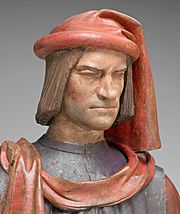
Lorenzo was prepared to take over leadership from a young age. When his father died in 1469, Lorenzo, at 20, became the main leader of Florence. The Medici Bank faced financial challenges during his time. This was due to his grandfather's building projects, wars, and political costs.
Like his family before him, Lorenzo ruled Florence indirectly. He used his influence over city councils through payments and arranged marriages. Other powerful families in Florence were often jealous of the Medici family's power.
The Pazzi Conspiracy
The Pazzi family was a major rival to the Medici. In 1478, they tried to overthrow Lorenzo's rule in an event called the Pazzi conspiracy. On April 26, 1478, a group attacked Lorenzo and his brother Giuliano in the Cathedral of Florence. Giuliano was killed, but Lorenzo escaped with a minor injury. The people of Florence were very angry about the attack. They quickly captured and punished those involved, including the archbishop of Pisa.
After the conspiracy, the Pope was very upset with Florence and the Medici family. He took all the Medici's money he could find. He also cut off Lorenzo and the Florentine government from the church. When this didn't work, the Pope teamed up with the King of Naples. Their army invaded Florence.
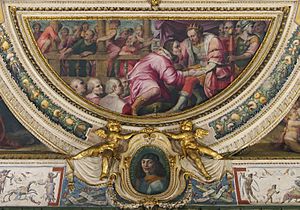
Lorenzo encouraged the citizens of Florence to fight back. However, Florence's usual allies did not offer much help. The war continued, so Lorenzo decided to go to Naples himself. He became a prisoner of the king for several months. This brave act eventually helped solve the crisis and brought peace. This success allowed Lorenzo to make changes to Florence's government, which gave him even more power.
Making Peace and Keeping Balance
After this, Lorenzo worked to keep peace in Italy. He tried to balance power among the northern Italian states. He also worked to keep powerful European countries like France and the Holy Roman Empire out of Italy. Lorenzo also had good relationships with the Ottoman Empire. Trade with them was a major source of wealth for Florence.
The Alum Mine Incident
Lorenzo's reputation was somewhat damaged by an incident involving alum mining. Alum is a mineral used in making glass, leather, and textiles. It was discovered by people in Volterra, who asked Florence for help to mine it. The Pope and the Medici Bank got involved in supporting the mining. The Pope received a fee for each unit of alum and made sure Florence had a monopoly.
However, the people of Volterra wanted the money from the mine for their own city. They did not want it going to their Florentine supporters. This led to a revolt, and some citizens were killed. Lorenzo sent soldiers to stop the revolt, and the soldiers ended up attacking the city. Lorenzo quickly went to Volterra to try and fix things. But this event remained a negative mark on his record.
A Champion of Art and Learning
Lorenzo's home was a hub for famous artists. These included Piero and Antonio del Pollaiuolo, Andrea del Verrocchio, Leonardo da Vinci, Sandro Botticelli, Domenico Ghirlandaio, and Michelangelo Buonarroti. These artists were key to the 15th-century Renaissance. While Lorenzo did not order many artworks himself, he helped these artists find other people to pay for their work. Michelangelo even lived with Lorenzo's family for three years. He ate at their table and joined in discussions with thinkers like Marsilio Ficino.
Lorenzo was also an artist himself and wrote poetry in his local language. In his poems, he celebrated life. But he also wrote about how fragile and uncertain human life can be, especially in his later works. His poems often focused on love, celebrations, and light.
Lorenzo's grandfather, Cosimo, started a collection of books that became the Medici Library. Lorenzo greatly expanded this library. He sent people to the East to find many old classical books. He also had a large team copy these books to share their knowledge across Europe. He supported the growth of humanism through his friends. These friends included philosophers like Marsilio Ficino, Poliziano, and Giovanni Pico della Mirandola. They studied ancient Greek thinkers and tried to combine their ideas with Christianity.
Lorenzo also used art to help with his diplomatic efforts. For example, he arranged for artists like Ghirlandaio and Botticelli to paint murals in the Sistine Chapel in Rome. This was seen as a way to strengthen the alliance between Lorenzo and the Pope.
In 1471, Lorenzo calculated that his family had spent a huge amount of money. Since 1434, they had spent about 663,000 florins on charity, buildings, and taxes. This would be around $460 million today.
His Family Life
Lorenzo married Clarice Orsini on February 7, 1469. The wedding ceremony took place in Florence on June 4, 1469. Clarice was the daughter of Giacomo Orsini, a lord from a powerful family.
Lorenzo and Clarice had 10 children together. All of them were born in Florence, except for one.
- Lucrezia Maria Romola de' Medici (1470–1553). She married Jacopo Salviati and had 10 children.
- Twin boys who died soon after birth in March 1471.
- Piero di Lorenzo de' Medici (1472–1503). He was called "the Unfortunate" and ruled Florence after his father.
- Maria Maddalena Romola de' Medici (1473–1528). She married Franceschetto Cybo and had seven children.
- Contessina Beatrice de' Medici, who died shortly after her birth in 1474.
- Giovanni di Lorenzo de' Medici (1475–1521). He became Pope Leo X in 1513.
- Luisa de' Medici (1477–1488). She was engaged to be married but died young.
- Contessina Antonia Romola de' Medici (1478–1515). She was born in Pistoia and married Piero Ridolfi.
- Giuliano di Lorenzo de' Medici (1479–1516). He became the Duke of Nemours.
Lorenzo also adopted his nephew Giulio di Giuliano de' Medici (1478–1534). Giulio was the son of Lorenzo's brother Giuliano, who had been killed. Lorenzo raised Giulio as his own son. Later, in 1523, Giulio became Pope Clement VII.
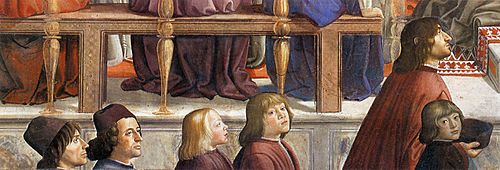
Later Years and Legacy
During Lorenzo's time, some parts of the family bank faced problems because of bad loans. In his later years, Lorenzo faced financial difficulties and used some public funds to help his family's bank.
Towards the end of Lorenzo's life, Florence was influenced by Savonarola. Savonarola was a religious leader who believed Christians had moved too far from their faith. Lorenzo played a role in bringing Savonarola to Florence.
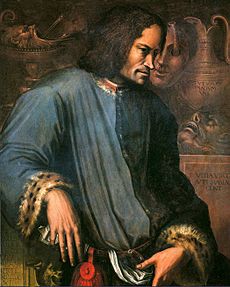
Lorenzo died late at night on April 8, 1492, at the family's villa in Careggi. Savonarola visited Lorenzo on his deathbed. Reports from people who were there say Lorenzo died peacefully after listening to a religious reading. Many strange signs were said to have happened when he died. These included lightning striking the dome of Florence Cathedral and ghosts appearing.
Lorenzo was buried with his brother Giuliano in the Church of San Lorenzo. Their tomb was originally designed for other family members. Later, in 1559, Lorenzo and Giuliano's bodies were moved to the New Sacristy. This area was designed by Michelangelo.
Lorenzo's oldest son, Piero di Lorenzo de' Medici, became the leader after him. Piero was known as "Piero the Unfortunate." In 1494, he lost his father's wealth and caused the Medici family to lose power in Florence. However, Lorenzo's second son, Giovanni, later became Pope Leo X. He helped the family regain control of Florence in 1512. In 1531, Lorenzo's nephew Giulio, whom Lorenzo had raised, became Pope Clement VII. Giulio made the Medici family the official rulers of Florence by making Alessandro de' Medici the first duke.
See also
 In Spanish: Lorenzo de Médici para niños
In Spanish: Lorenzo de Médici para niños


